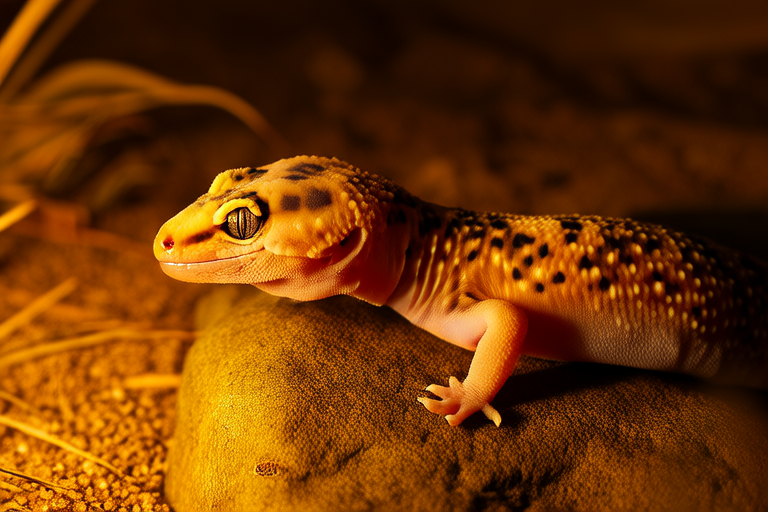Leopard Gecko Care: A Beginner’s Ultimate Guide
Welcome to your comprehensive guide on how to care for a leopard gecko, one of the most popular reptile pets among beginners. This guide will cover everything from understanding what makes leopard geckos unique to setting up their habitat, providing proper nutrition, and ensuring their health.
Introduction to Leopard Geckos
Leopard geckos (Eublepharis macularius) are small, nocturnal lizards native to the arid regions of Pakistan, Afghanistan, and parts of India. They are known for their docile nature, making them ideal pets for first-time reptile owners. Leopard geckos come in various colors and patterns, adding an aesthetic appeal to their already charming personalities.
Housing Requirements
Tank Size
The minimum tank size for a single leopard gecko is 10 gallons; however, a larger enclosure is recommended to provide more space for exploration and exercise. For each additional gecko, add another 5 gallons to the tank size.
Substrate
Selecting appropriate bedding or substrate is crucial for your gecko’s safety and well-being. Avoid loose substrates like sand or wood shavings, which can cause impaction if ingested. Instead, opt for safer alternatives such as paper towels, reptile carpet, or eco-friendly paper-based substrates designed specifically for reptiles.
Hiding Spots
Leopard geckos require hiding spots to feel secure and comfortable within their environment. Provide at least two hide boxes—one on the warm side of the tank and another on the cool side—to allow thermoregulation. These hides can be simple cardboard boxes or commercially available plastic caves.
Temperature and Lighting Needs
Thermoregulation
Maintaining a proper temperature gradient within the enclosure is vital for your gecko’s health. The warm side should range between 88°F and 90°F (31°C-32°C), while the cooler side should be around 75°F to 80°F (24°C-27°C). Use a digital thermometer with probes placed at both ends of the tank to monitor these temperatures accurately.
Heat Sources
Adequate heating can be achieved through under-tank heaters or ceramic heat emitters. Always ensure that the heat source does not produce direct contact with your gecko, as burns may occur. Position the heater so it heats only half of the tank, creating a thermal gradient.
Lighting
Unlike some other reptiles, leopard geckos do not require UVB lighting because they synthesize vitamin D3 through their skin. However, providing low-level ambient lighting during the day helps maintain a regular day-night cycle. Use LED lights that emit minimal heat to avoid overheating the enclosure.
Diet and Feeding Habits
Leopard geckos are insectivores, meaning their diet consists primarily of live insects. Crickets, mealworms, dubia roaches, and waxworms are common choices. Offer appropriately sized prey items—too large can cause digestive issues, while too small might not meet nutritional needs.
Supplements
To ensure optimal health, dust feeder insects with calcium powder containing vitamin D3 before feeding them to your gecko. Additionally, provide multivitamin supplements weekly to prevent deficiencies.
Health Care and Common Diseases
Preventive Measures
Regular veterinary checkups and maintaining clean living conditions are key to preventing illness. Quarantine new additions to your collection until you confirm they are healthy.
Common Issues
Metabolic bone disease (MBD) results from insufficient calcium intake or improper calcium-to-phosphorus ratio in the diet. Symptoms include weak limbs, swollen joints, and difficulty moving. Proper supplementation and balanced diet help prevent MBD.
Handling Tips
When handling your leopard gecko, always support its body fully and avoid excessive squeezing or constriction. Allow them to acclimate gradually to human interaction by offering treats during brief sessions initially.
Advice for Choosing the Right Gecko as a Pet
Consider factors such as lifespan, temperament, and care requirements when selecting a leopard gecko. With proper care, these lizards can live up to 20 years, so commit to long-term responsibility.
Ensure that any potential pet has been captive-bred rather than wild-caught, as captive-bred animals tend to adapt better to captivity and have lower stress levels. Research breeders thoroughly to find reputable sources.
Lastly, prepare adequately by researching extensively about leopard gecko care before bringing one home. This includes setting up the appropriate habitat, understanding dietary needs, and being aware of common health concerns.
By following this guide, you’ll set yourself and your new friend up for success in creating a happy, healthy life together. Enjoy your journey into the fascinating world of leopard gecko ownership!
